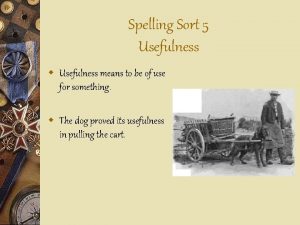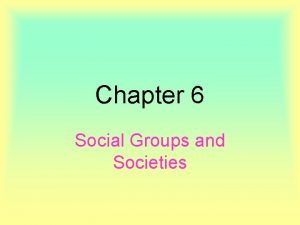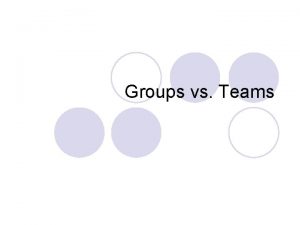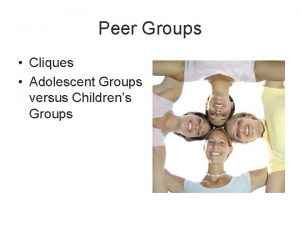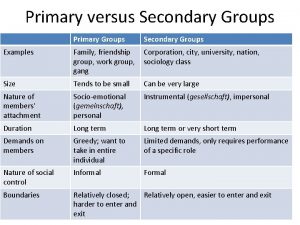16 Groups and Change The usefulness of groups


















- Slides: 18

16 Groups and Change The usefulness of groups is nowhere more apparent than when groups are used to help their members change. Groups, by their very nature, provide their members with information, support, and guidance, and so many personal and interpersonal problems can be resolved more readily when confronted in a group rather than alone. v. What are some of the ways that groups are used to help members change? v. How do groups promote change? v. How effective are groups in bringing about change?

Preview Groups and Change Types Group psychothera py Interpersonal learning groups Support groups Curative Factors in groups Effectiveness Universality & Hope Perceptions vs. behavior Social learning Negative effects Cohesion Types and Outcomes Disclosure & catharsis Overall value Altruism Insight

Lewin’s Law of Change “It is usually easier to change individuals formed into a group than to change any of them separately. ” Basic “types” of therapeutic groups Psychotherapy groups Interpersonal learning groups Support (self-help) groups

Group Psychotherapy Group Psychoanalysis Gestalt Groups Types Psychodrama Interpersonal Group Psychotherapy Cognitive-behavioral therapy groups

Group Psychoanalysis q Freud’s discussed group processes in his book Group Psychology and the Analysis of Ego q Freud did not conduct therapy in groups, but other analysis did v gaining insight into problems v interpretations and working through sibling and parental transference The First Committee Of The Vienna Psychoanalytical Society [Source: Berlin, 1922 Becker Maas, Library of Congress (124), (LC-USZ 62 -119779)] From Left to Right: Otto Rank, Sigmund Freud, Karl Abraham, Max Eitingon, Sàndor Ferenczi, Ernest Jones, Hans Sachs

Gestalt Group Psychotherapy v This approach is based on the work of Fritz Perls, who maintained people tend to fail to accept and integrate their experiences, thoughts, and emotions v Goal was to achieve phenomenological unity (a gestalt) v When conducted in groups, stressed emotional growth using experiments and role‑playing methods (e. g. , the hot seat, empty seat, etc. ).

Psychodrama v Jacob Moreno, who coined the word sociometry and developed the method, also made use of groups in treatment v Psychodrama involves acting out experiences in the group, role-playing, and imitation

Interpersonal Group Psychotherapy v Therapeutic methods that use the group itself as a “social microcosm” where members, during the course of their interactions with one another, gain insights and develop interpersonal skills v Irvin Yalom’s interactive process groups, for example, emphasize analysis of ongoing interactions in the group (a “here and now” orientation) by all members

Cognitive‑behavioral therapy groups v. Make use of methods developed in cognitive-behavioral therapies, but do so in a group setting v Often used for more specific issues, such as phobias, depression, drug addiction, sexual offenses, and so on. v. Behavioral contracts, modeling, behavior rehearsal, feedback http: //www. nytimes. com/2007/03/06/ us/06 civil. html

Interpersonal Learning Groups Older Forms q Training groups, or T‑groups q Growth groups (sensitivity‑traini ng groups or encounter groups) Contemporary Forms q Structured learning groups (workshops) such as Lifespring, actualization training, Pathworks, life dynamics, etc.

Self-help Groups v Problem-specific: deal with a specific problem or concern, such as alcohol, physical illness v Interpersonal: members establish strong ties to each other v Communal: group stresses community and sharing v Autonomous: little or no fee is charged for membership, and leaders are volunteers rather than professionals v Perspective-based: Often adopt a particular “perspective” on the issue and its causes (e. g. , AA)

Examples of Support Groups

Sources of Change in Groups

Sources of Change in Groups Curative factors (therapeutic factors) in groups § q q Universality: We all have problems Hope: If others can change, so can I v Upward social comparison v Hope: sense of efficacy and multiple pathways q Vicarious learning: I learn by watching others. v Social learning theory

Sources of Change in Groups Interpersonal learning: I’m learning to get along better with people. q Guidance: Members give me good suggestions. q v Leadership q q q and co-leadership Cohesion and support: The group takes me in and sustains me. q Group development and therapeutic interventions q q Self-disclosure: It feels better to share these secrets. Catharsis: I’ve gotten some anger off my chest. Altruism: Helping others makes me feel more confident in myself. Insight: I’ve learned a lot about myself.

Sources of Change in Groups Members most value universality, interpersonal learning, cohesion/support, and insight § Application to traumatic events § q q Victims of negative events, such as floods, terrorism Interventions involve the curative factors, particularly hope, guidance, cohesion, opportunities for self-disclosure, and altruism.

How Effective are Groups? § Group approaches are as effective as individual methods § Limitations § q Changes are often more perceptual than behavioral q Premature termination q Psychological casualty Group methods, despite their diversity, tend to be equally effective.

Preview Groups and Change Types Group psychothera py Interpersonal learning groups Support groups Curative Factors in groups Effectiveness Universality & Hope Perceptions vs. behavior Social learning Negative effects Cohesion Types and Outcomes Disclosure & catharsis Overall value Altruism Insight
 Time utility examples
Time utility examples Images of useful and harmful materials
Images of useful and harmful materials Higher history evaluate the usefulness
Higher history evaluate the usefulness Evaluate the usefulness
Evaluate the usefulness Information approach to decision usefulness
Information approach to decision usefulness Decision usefulness theory
Decision usefulness theory Diaphorisis
Diaphorisis How are ethnic groups and religious groups related
How are ethnic groups and religious groups related Physical changes vs chemical changes
Physical changes vs chemical changes Absolute change and relative change formula
Absolute change and relative change formula Difference between physical change and chemical change
Difference between physical change and chemical change Change in supply and change in quantity supplied
Change in supply and change in quantity supplied Examples of physical vs chemical changes
Examples of physical vs chemical changes Rocks change due to temperature and pressure change
Rocks change due to temperature and pressure change Whats the difference between a chemical and physical change
Whats the difference between a chemical and physical change First-order and second-order change examples
First-order and second-order change examples Hình ảnh bộ gõ cơ thể búng tay
Hình ảnh bộ gõ cơ thể búng tay Ng-html
Ng-html Bổ thể
Bổ thể




















